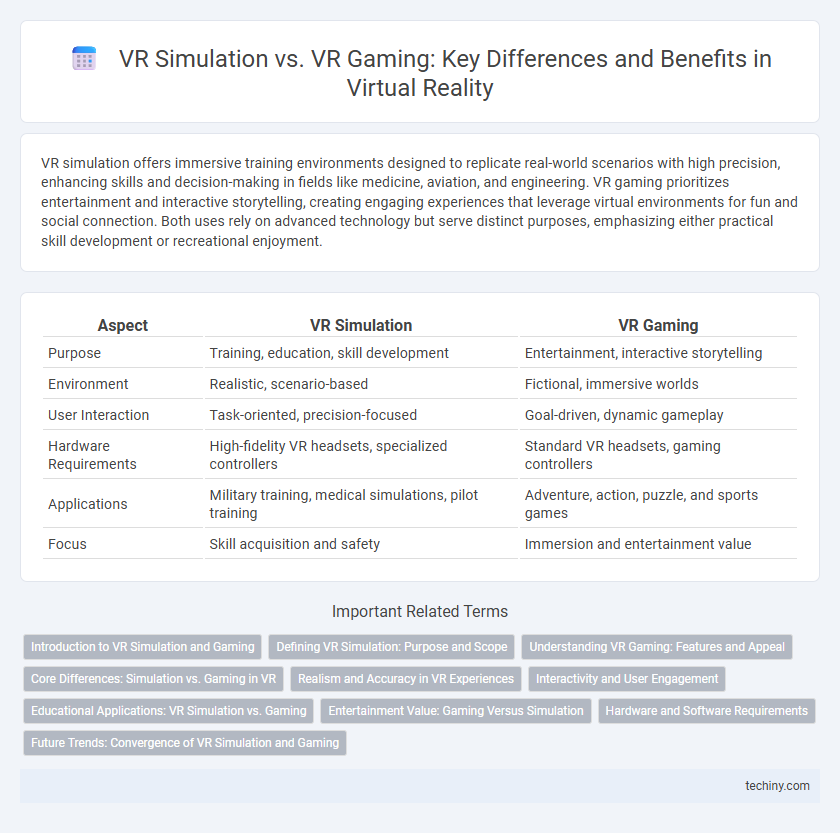VR simulation offers immersive training environments designed to replicate real-world scenarios with high precision, enhancing skills and decision-making in fields like medicine, aviation, and engineering. VR gaming prioritizes entertainment and interactive storytelling, creating engaging experiences that leverage virtual environments for fun and social connection. Both uses rely on advanced technology but serve distinct purposes, emphasizing either practical skill development or recreational enjoyment.
Table of Comparison
| Aspect | VR Simulation | VR Gaming |
|---|---|---|
| Purpose | Training, education, skill development | Entertainment, interactive storytelling |
| Environment | Realistic, scenario-based | Fictional, immersive worlds |
| User Interaction | Task-oriented, precision-focused | Goal-driven, dynamic gameplay |
| Hardware Requirements | High-fidelity VR headsets, specialized controllers | Standard VR headsets, gaming controllers |
| Applications | Military training, medical simulations, pilot training | Adventure, action, puzzle, and sports games |
| Focus | Skill acquisition and safety | Immersion and entertainment value |
Introduction to VR Simulation and Gaming
VR simulation creates immersive environments for training, education, and professional applications by replicating real-world scenarios with high precision and interaction fidelity. VR gaming emphasizes entertainment, integrating engaging narratives and responsive gameplay to deliver captivating player experiences through virtual worlds. Both leverage advanced VR hardware and software technologies but differ fundamentally in purpose and user engagement metrics.
Defining VR Simulation: Purpose and Scope
VR simulation serves primarily as a tool for training, education, and skill development by replicating real-world environments with high accuracy. Unlike VR gaming, which emphasizes entertainment and interactive storytelling, VR simulation focuses on practical applications such as medical procedures, pilot training, and industrial operations. The purpose and scope of VR simulation aim to enhance experiential learning and improve performance in professional settings through immersive, controlled scenarios.
Understanding VR Gaming: Features and Appeal
VR gaming offers immersive experiences combining interactive gameplay with realistic environments, leveraging advanced graphics and haptic feedback technologies. Key features include motion tracking, multiplayer capabilities, and customizable avatars, which enhance player engagement and social interaction. The appeal of VR gaming lies in its ability to transport users into virtual worlds, providing escapism, challenge, and innovative entertainment beyond traditional gaming formats.
Core Differences: Simulation vs. Gaming in VR
VR simulation emphasizes realistic environments and scenarios for training, education, or professional use, prioritizing accuracy and immersion to replicate real-world experiences. VR gaming focuses on entertainment, combining interactive storytelling, challenges, and user engagement with imaginative and often fantastical settings. Core differences lie in purpose and design: simulations aim to mirror reality for skill development, while gaming centers on enjoyment and virtual escapism.
Realism and Accuracy in VR Experiences
VR simulation prioritizes realism and accuracy by replicating real-world environments and scenarios with precise spatial mapping, physics, and sensory feedback, critical for professional training and education. VR gaming emphasizes immersive experiences and interactivity, often sacrificing some accuracy for engaging visuals and dynamic gameplay. The level of detail in VR simulations enhances skill transfer and decision-making, while VR gaming focuses on entertainment and user engagement.
Interactivity and User Engagement
VR simulation offers highly realistic environments designed for training and skill development, emphasizing precise interactivity to mirror real-world scenarios. VR gaming prioritizes immersive entertainment through dynamic user engagement, featuring responsive gameplay mechanics and adaptive challenges. Both leverage advanced sensory feedback systems to enhance the user's sense of presence and interactivity, but simulations focus on accuracy while gaming emphasizes fun and exploration.
Educational Applications: VR Simulation vs. Gaming
VR simulation offers immersive, realistic environments tailored for educational applications by replicating complex scenarios such as surgical procedures or engineering workflows, enhancing hands-on learning and skill acquisition. In contrast, VR gaming emphasizes entertainment through interactive storytelling and challenges, which can still support education by improving engagement, memory retention, and problem-solving skills in a gamified context. Both VR simulation and gaming leverage spatial awareness and virtual interaction, but simulation prioritizes accuracy and task-specific training, while gaming focuses on motivation and enjoyment in the learning process.
Entertainment Value: Gaming Versus Simulation
VR gaming offers highly interactive and immersive experiences designed to maximize entertainment value through dynamic gameplay, challenges, and storylines. VR simulation prioritizes realism and accuracy, often used for training or educational purposes, which may limit its appeal for pure entertainment compared to gaming. The entertainment value in VR games is driven by engagement and fun, while VR simulations focus on authenticity and skill development.
Hardware and Software Requirements
VR simulation demands high-precision hardware such as advanced motion tracking sensors, haptic feedback devices, and professional-grade headsets to ensure accurate real-world replication, while VR gaming typically requires consumer-grade VR headsets like Oculus Quest or HTC Vive optimized for interactive entertainment. Software for VR simulation prioritizes realistic physics engines, precise spatial mapping, and specialized scenario programming, whereas VR gaming software focuses on immersive graphics, game mechanics, and user interface design. Hardware latency and software compatibility critically impact the performance and user experience in both VR simulation and gaming environments.
Future Trends: Convergence of VR Simulation and Gaming
VR simulation and gaming are increasingly converging as advancements in artificial intelligence, haptic feedback, and realistic graphics blur the lines between training scenarios and immersive entertainment. Future trends emphasize the integration of adaptive learning algorithms to create personalized, interactive environments that serve both educational and recreational purposes. This fusion leverages the growing demand for experiential content, driving innovation in hardware and software platforms to enhance user engagement across industries.
VR simulation vs VR gaming Infographic

 techiny.com
techiny.com